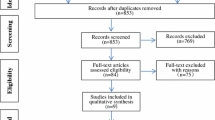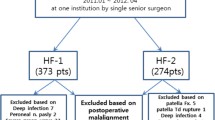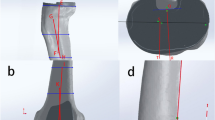Abstract
Purpose
High-flexion knee prosthesis designs are generally thought to be of benefit only in patients with a satisfactory preoperative flexion angle. The aim of the study was to evaluate whether high-flexion designs were indeed worthless in osteoarthritis patients with severe preoperative flexion limitation.
Methods
The postoperative maximum flexion was compared in osteoarthritis patients with a preoperative maximum flexion of 100° or less, using LPS and LPS-flex implants (NexGen®; Zimmer, Warsaw, IN) in total knee arthroplasties. Data on 39 knees in the LPS group and 41 in the LPS-flex group, with a minimum of 2 years of follow-up, were reviewed retrospectively, focused on the postoperative maximum flexion.
Results
Two years after operation, the LPS-flex group had a mean postoperative maximum flexion of 131 ± 10° (range, 105–140°), which was significantly higher than the 121 ± 12° (range, 95–140°) in the LPS group (P < 0.001). In the LPS-flex group, about half of the knees (n = 18, 44%) could achieve a maximum flexion of 140° postoperatively, but in the LPS group only five knees (13%) achieved a maximum flexion of 140°.
Conclusion
Despite a different period of the operation between groups, this study suggested that osteoarthritis patients with severe preoperative flexion limitation could achieve more postoperative gain in flexion when a high-flexion prosthesis was used, compared to the flexion obtained using a standard prosthesis.

Similar content being viewed by others
References
Anouchi YS, McShane M, Kelly F Jr et al (1996) Range of motion in total knee replacement. Clin Orthop Relat Res 331:87–92
Argenson JN, Komistek RD, Mahfouz M et al (2004) A high flexion total knee arthroplasty design replicates healthy knee motion. Clin Orthop Relat Res 428:174–179
Argenson JN, Scuderi GR, Komistek RD et al (2005) In vivo kinematic evaluation and design considerations related to high flexion in total knee arthroplasty. J Biomech 38:277–284
Banks S, Bellemans J, Nozaki H et al (2003) Knee motions during maximum flexion in fixed and mobile-bearing arthroplasties. Clin Orthop Relat Res 410:131–138
Bellemans J, Banks S, Victor J et al (2002) Fluoroscopic analysis of the kinematics of deep flexion in total knee arthroplasty. Influence of posterior condylar offset. J Bone Joint Surg Br 84:50–53
Bin SI, Nam TS (2007) Early results of high-flex total knee arthroplasty: comparison study at 1 year after surgery. Knee Surg Sports Traumatol Arthrosc 15:350–355
Cibere J, Bellamy N, Thorne A et al (2004) Reliability of the knee examination in osteoarthritis: effect of standardization. Arthritis Rheum 50:458–468
Faul F, Erdfelder E, Lang AG et al (2007) G*Power 3: a flexible statistical power analysis program for the social, behavioral, and biomedical sciences. Behav Res Methods 39:175–191
Gandhi R, Tso P, Davey JR et al (2009) High-flexion implants in primary total knee arthroplasty: a meta-analysis. Knee 16:14–17
Gupta SK, Ranawat AS, Shah V et al (2006) The P.F.C. sigma RP-F TKA designed for improved performance: a matched-pair study. Orthopedics 29:S49–S52
Huddleston JI, Scarborough DM, Goldvasser D et al (2009) 2009 Marshall Urist Young Investigator Award: how often do patients with high-flex total knee arthroplasty use high flexion? Clin Orthop Relat Res 467:1898–1906
Jakobsen TL, Christensen M, Christensen SS et al (2009) Reliability of knee joint range of motion and circumference measurements after total knee arthroplasty: does tester experience matter? Physiother Res Int doi:10.1002/pri.450
Kim YH, Choi Y, Kim JS (2009) Range of motion of standard and high-flexion posterior cruciate-retaining total knee prostheses a prospective randomized study. J Bone Joint Surg Am 91:1874–1881
Kim YH, Choi Y, Kwon OR et al (2009) Functional outcome and range of motion of high-flexion posterior cruciate-retaining and high-flexion posterior cruciate-substituting total knee prostheses. A prospective, randomized study. J Bone Joint Surg Am 91:753–760
Kim YH, Sohn KS, Kim JS (2005) Range of motion of standard and high-flexion posterior stabilized total knee prostheses. A prospective, randomized study. J Bone Joint Surg Am 87:1470–1475
Komistek RD, Scott RD, Dennis DA et al (2002) In vivo comparison of femorotibial contact positions for press-fit posterior stabilized and posterior cruciate-retaining total knee arthroplasties. J Arthroplasty 17:209–216
Kotani A, Yonekura A, Bourne RB (2005) Factors influencing range of motion after contemporary total knee arthroplasty. J Arthroplasty 20:850–856
Lavernia C, D’Apuzzo M, Rossi MD et al (2008) Accuracy of knee range of motion assessment after total knee arthroplasty. J Arthroplasty 23:85–91
Li G, Most E, Sultan PG et al (2004) Knee kinematics with a high-flexion posterior stabilized total knee prosthesis: an in vitro robotic experimental investigation. J Bone Joint Surg Am 86:1721–1729
Massin P, Gournay A (2006) Optimization of the posterior condylar offset, tibial slope, and condylar roll-back in total knee arthroplasty. J Arthroplasty 21:889–896
Moro-oka T, Matsuda S, Miura H et al (2002) Patellar tracking and patellofemoral geometry in deep knee flexion. Clin Orthop Relat Res 394:161–168
Myles CM, Rowe PJ, Walker CR et al (2002) Knee joint functional range of movement prior to and following total knee arthroplasty measured using flexible electrogoniometry. Gait Posture 16:46–54
Nakagawa S, Kadoya Y, Kobayashi A et al (2003) Kinematics of the patella in deep flexion. Analysis with magnetic resonance imaging. J Bone Joint Surg Am 85:1238–1242
Ng FY, Wong HL, Yau WP et al (2008) Comparison of range of motion after standard and high-flexion posterior stabilised total knee replacement. Int Orthop 32:795–798
Nutton RW, van der Linden ML, Rowe PJ et al (2008) A prospective randomised double-blind study of functional outcome and range of flexion following total knee replacement with the NexGen standard and high flexion components. J Bone Joint Surg Br 90:37–42
Parsley BS, Engh GA, Dwyer KA (1992) Preoperative flexion. Does it influence postoperative flexion after posterior-cruciate-retaining total knee arthroplasty? Clin Orthop Relat Res 275:204–210
Ranawat CS (2003) Design may be counterproductive for optimizing flexion after TKR. Clin Orthop Relat Res 416:174–176
Ritter MA (2006) High-flexion knee designs: more hype than hope? in the affirmative. J Arthroplasty 21:40–41
Ritter MA, Berend ME, Harty LD et al (2004) Predicting range of motion after revision total knee arthroplasty: clustering and log-linear regression analyses. J Arthroplasty 19:338–343
Ritter MA, Harty LD, Davis KE et al (2003) Predicting range of motion after total knee arthroplasty. Clustering, log-linear regression, and regression tree analysis. J Bone Joint Surg Am 85:1278–1285
Seon JK, Park SJ, Lee KB et al (2009) Range of motion in total knee arthroplasty: a prospective comparison of high-flexion and standard cruciate-retaining designs. J Bone Joint Surg Am 91:672–679
Sultan PG, Most E, Schule S et al (2003) Optimizing flexion after total knee arthroplasty: advances in prosthetic design. Clin Orthop Relat Res 416:167–173
Victor J, Ries M, Bellemans J et al (2007) High-flexion, motion-guided total knee arthroplasty: who benefits the most? Orthopedics 30:77–79
Weeden SH, Schmidt R (2007) A randomized, prospective study of primary total knee components designed for increased flexion. J Arthroplasty 22:349–352
Acknowledgments
This research was supported by Basic Science Research Program through the National Research Foundation of Korea (NRF) funded by the Ministry of Education, Science and Technology (2010-0001733).
Author information
Authors and Affiliations
Corresponding author
Rights and permissions
About this article
Cite this article
Lee, BS., Kim, JM., Lee, SJ. et al. High-flexion total knee arthroplasty improves flexion of stiff knees. Knee Surg Sports Traumatol Arthrosc 19, 936–942 (2011). https://doi.org/10.1007/s00167-010-1272-4
Received:
Accepted:
Published:
Issue Date:
DOI: https://doi.org/10.1007/s00167-010-1272-4




